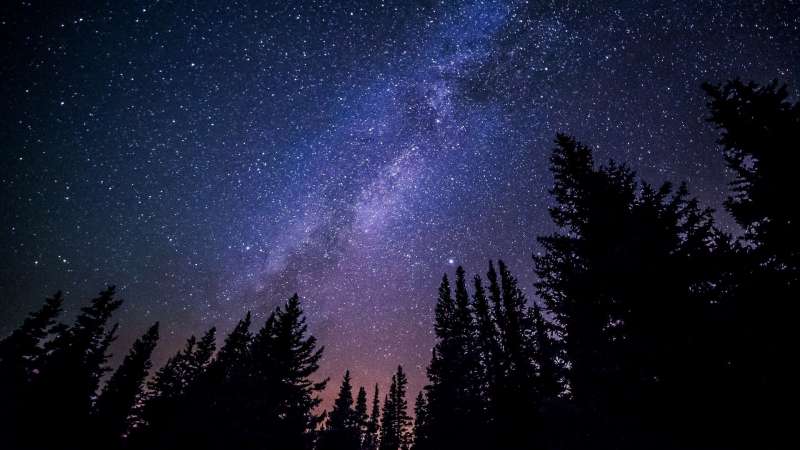Nearly all the pollutants in our everyday environment can be found easily — albeit less problematically — when one leaves our planet’s surface. Ozone is the most ironic example, restricted at ground level and protected above. And the atmospheres of Mars and Venus are mostly carbon dioxide, which at least in our atmosphere, where it is only a trace gas, the Supreme Court says it can nonetheless be mitigated under the Clean Air Act.
The largest source of what would be regulated pollutants on Earth can be found in what Jay Lockman, principal scientist of the Green Bank Observatory in West Virginia, calls “the Milky Way’s atmosphere” — properly, the interstellar medium. In a cosmic irony, the scientific instruments that detect interstellar atoms and molecules are potentially jeopardized by an anthropogenic source of extraterrestrial pollution — the industrialization of low-Earth orbit.
 Astronomers have discovered that the molecules behind biology can be found where the interstellar medium is dense and cold enough that gravitational attraction can overcome thermal energy, resulting in the collapse of gas clouds into new stars. The most massive stars burn out quickly and explode in supernovae, enriching the interstellar medium with the products of nucleosynthesis. This process yields elements like oxygen, carbon, nitrogen, and sulfur which, along with already abundant hydrogen, constitute some of the most basic building blocks of terrestrial biology. It also yields mercury, regulated as a CAA pollutant; arsenic, restricted as a drinking water contaminant; and lead, regulated as both. Our sun and its planets formed from this enriched medium. We thus got some of the elemental good stuff and bad stuff at birth.
Astronomers have discovered that the molecules behind biology can be found where the interstellar medium is dense and cold enough that gravitational attraction can overcome thermal energy, resulting in the collapse of gas clouds into new stars. The most massive stars burn out quickly and explode in supernovae, enriching the interstellar medium with the products of nucleosynthesis. This process yields elements like oxygen, carbon, nitrogen, and sulfur which, along with already abundant hydrogen, constitute some of the most basic building blocks of terrestrial biology. It also yields mercury, regulated as a CAA pollutant; arsenic, restricted as a drinking water contaminant; and lead, regulated as both. Our sun and its planets formed from this enriched medium. We thus got some of the elemental good stuff and bad stuff at birth.
Further, in stellar nurseries these atoms are shielded from ultraviolet radiation by small dust particles, which if in the Earth’s troposphere would be regulated under the CAA. This particulate matter allows the interstellar gas temperature to fall and molecules to form. Unfortunately for astronomers working with large optical telescopes, these dust clouds show up as dark nebulae — opaque regions in space.
But radio telescopes like Lockman’s have revealed that the clouds contain molecules basic to life. And in another cosmic irony clouds have also brewed up simple chemicals that would be regulated on Earth. The bad stuff includes sulfur dioxide, nitrogen oxides, and carbon monoxide, which are criteria air pollutants, plus other substances restricted by other means, such as carbon dioxide, formaldehyde, methane, and ammonia. CO2 in the right concentrations is of course also a beneficial chemical for plant life, and the list of good interstellar stuff contains water, protected under the Clean Water Act and Safe Drinking Water Act. Lockman notes the list also includes many organic molecules typical of those that nurture life on our planet today.
Earth formed from all this. Fortunately, plate tectonics and atmospheric conditions massaged these elements and compounds, good and bad alike, into conditions suitable for the biosphere to start up. But lately, we humans have begun replicating the simple chemistry of dark nebulae, creating and releasing into our own environment the pollutants that now endanger all life on Earth.
So it is sad to report that radio telescopes — critical instruments of information about the enriching conditions of dark nebulae and everything else back to the Big Bang — are a threatened species. Optical telescopes are endangered by light pollution that everyone can see. So it is less well known that radio telescopes are jeopardized by invisible electromagnetic pollution, not just sources like TV transmitters but from garage openers and other devices that have stronger signals than do twitches from millions of light years away.
The U.S. National Science Foundation’s 100-meter-diameter dish at Green Bank is surrounded by a 13,000-square-mile multi-state regulatory National Radio Quiet Zone, where signals from new transmitters are controlled so that they don’t interfere with the big dish and other radio telescopes at the facility. Close to the Green Bank telescopes, even microwave ovens, wifi routers, and cell phones are closely regulated.
Unfortunately, discoveries about how the basics of life came to be included in the formation of the Earth are endangered by a new kind of pollution, a source that is virtually unregulated. The skies have become filled with 3,200 functioning satellites whose transmitters blind radio telescopes at critical frequencies.
Worse, entrepreneurs are rushing tens of thousands of additional satellites into orbit to bring the Internet to every square meter of the Earth. In 2019, Elon Musk’s SpaceX launched the first of 12,000 satellites, each to be radio linked with each other so they can envelope the entire terrestrial surface in electromagnetic radiation.
“It is unfortunate,” says Lockman, “that satellites designed for communication on Earth are increasingly preventing us from learning about our place in the universe. We need to be good stewards of the radio spectrum as well as our physical environment.”
